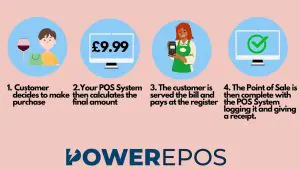Our editorial details how to use a POS system effectively. From understanding what a POS system is to setting it up and utilising its features for hospitality purposes, we will cover it all.
What is a POS System?
A POS system, or Point of Sale system, is a combination of hardware and software that enables businesses to manage sales transactions and streamline their operations efficiently. This technology has evolved significantly from traditional cash tills and now offers a wide range of functionalities. At Power Epos, we have put together a similar graphic below to show you the basic streamline process.
Basic Operations on Using a POS System
- Card Reader: A card reader is an essential component of a modern business. It allows businesses to accept various forms of payment, such as credit and debit cards. To use it, simply swipe, dip, or tap the customer’s card, and the system will process the payment securely.
- Cash Drawer: The cash drawer is where cash transactions are handled. When a customer pays with cash, the cashier opens the drawer and counts the money. The system will then record the sale and calculate change if necessary.
- Barcode Scanner: Barcode scanners are invaluable for businesses with large inventories. To use a barcode scanner, scan the barcode on a product, and the system will automatically add it to the transaction. This not only speeds up the checkout process but also reduces the chances of errors.
Reporting: To generate reports, navigate to the reporting section of your POS software and select the desired parameters. You can track sales trends, monitor inventory levels, and make informed decisions based on these reports.
How to Use a POS System in the Hospitality Industry
EPOS systems for Bars help you to provide better service to your valuable customers while keeping an eagle eye on sales, security, costs and inventory
- Order Management: Streamline drink and food orders with your bar POS system. Servers can quickly input orders, and bartenders receive them instantly, ensuring prompt service.
- Inventory Tracking: Keep tabs on your bar inventory in real-time. Monitor alcohol stock levels and set up alerts for low quantities to avoid running out of popular drinks during busy hours
- Customised Menus: Easily update your bar menu with new cocktails, seasonal specials, and happy hour promotions. A dynamic menu ensures that customers are aware of your offerings.
- Tab Management: Manage open tabs and split bills effortlessly, providing flexibility for your customers and ensuring accurate billing.
Hospitality businesses, such as bars, restaurants and cafes, can optimise their operations with a POS system tailored to their needs:
How to Set Up a POS System
Setting up a POS system may seem daunting, but it can be broken down into manageable steps:
Install and Launch Your Software: Begin by installing the POS software on your chosen devices. Follow the installation instructions provided by your POS provider. Once installed, launch the software and complete any initial setup steps.
Connect Your Hardware: Connect the necessary hardware components, such as card readers, cash drawers, and barcode scanners, to your POS system. Ensure they are properly connected and recognised by the software.
Set Up Your Inventory: Input your inventory items into the system, including product names, prices, and quantities. Organise your products into categories for easy navigation.
Enter User Accounts and Permissions: Create user accounts for your staff members and assign appropriate permissions. This ensures that only authorised personnel can access sensitive information and perform specific actions.
Set Up Payment Methods: Configure the accepted payment methods, including cash, credit cards, and digital wallets. Test each payment method to ensure they are functioning correctly.
Integrate Your POS With Other Software: If necessary, integrate your POS system with other software solutions, such as accounting or customer relationship management (CRM) software. This integration streamlines data flow and reduces manual data entry.
Seek Help From Your POS Supplier: If you encounter any issues or require further assistance during the setup process, don’t hesitate to reach out to your POS supplier’s customer support. They can provide guidance and troubleshoot any problems you may encounter.
Final Words
As our guide proves this can be a very powerful tool that can enhance the efficiency and profitability of your business, whether you operate in retail or hospitality.
By understanding the basic operations of the system and following the steps to set it up effectively, you can streamline your operations, gain valuable insights, and provide a seamless experience for your customers. Keep in mind that as technology continues to evolve, staying up to date with the latest POS trends and features is essential to remain competitive in the market.


